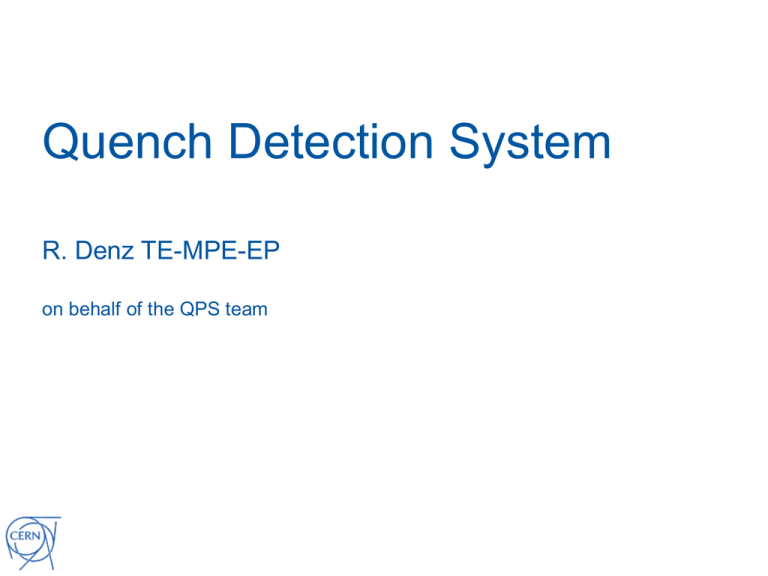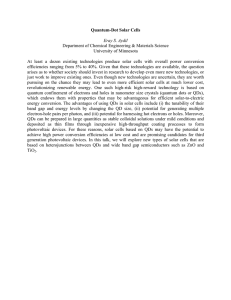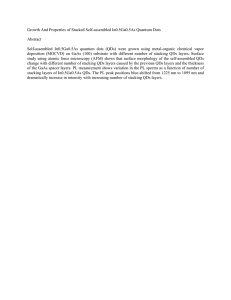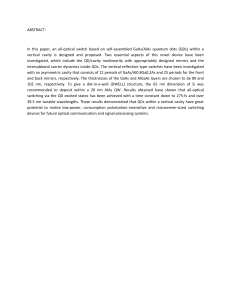Quench Detection System
advertisement

Quench Detection System R. Denz TE-MPE-EP on behalf of the QPS team Outline • Upgrade of the LHC quench detection system (QDS) during LS1 • • Yellow racks & R2E QDS system dependability during LHC operation in 2015 • Overall system performance Upgrades performed in 2015 Experience during the ion run • • • Preparation for 2016 operation • Firmware upgrade for nQPS DAQ systems Deployment of radiation tolerant QDS for 600 A circuits • • • Includes RU.L4 and RU.R4 Expected system performance in 2016 2 QDS upgrade during LS1 • QPS system dependability Overhaul of MB protection systems (“Yellow racks”) Revision of safety critical firmware Automatic system configuration and verification R2E framework: • • • • • • • Relocation of equipment (Inner Triplet protection) Deployment of radiation tolerant electronics (IPQ, IPD) Enhancement of supervision & diagnostic capabilities • • • • Enhanced quench heater circuit supervision Earth voltage feelers QPS fieldbus upgrade CSCM for all sectors (objective added in 2014) 3 Enhanced quench heater circuit supervision heatermagnets resistance for mainQuench dipole recorded during discharge • revealing a damaged heater strip The new systems record simultaneously the discharge in MB A26R8. voltage and current at sampling rates up to 192 kHz and 16 Bit resolution • • • • Discharge current is measured with the help of dedicated precision measurement transformers. Special mode to detect blown internal fuse of the quench heater power supply indicating a potential heater isolation fault. Successful detection of a damaged heater strip in A26R8. The heater strip has been isolated and replaced by a low field heater. The new systems are so far only available for MB magnets. In the midterm, it is foreseen deploying these type of systems for all magnets protected by quench heaters. 4 About quench heater circuit usage ... Statistics for LHC main dipoles, 2014-2015 • Data provided by Zinur Charifoulline: No firing campaign scheduled for 2016 Expected to be less in 2016 5 Improved availability & maintainability • Remote control options • •MPE Remote power cycle of detection crates stand-by service statistics for QDS+DAQ interventions •• Re-start ofofstalled communication busses In 2015 14% all interventions were requiring access to the LHC compared to 41% in 2012! Automatic re-start of stalled field-bus couplers • • • 11 interventions requiring access in 2012, fully transparent in 2015 Update of QPS supervision FESA2 FESA3 • Configuration management • QPS field-bus upgrade higher data transmission rates • Revision of LOGGING data retrieval • Analog data recorded without dead-bands • Installation of earth voltage feelers for the main circuits • 6 System immunity to ionizing radiation (R2E) Relocation of QPS equipment previously installed in UJ14, UJ16, UJ56 • • Inner triplet protection Deployment of radiation tolerant electronics for quench detection systems for IPQ and IPD protection Ghosts from the past ... Deployment of radiation tolerant electronics for quench detection systems for 600 A protection • • • • Upgrade started - to be completed during YETS 7 • Challenging year after major system upgrades during LS1 • Smooth operation @ ~96% Significant (not foreseen) effort to overcome post LS1 teething problems affecting overall system availability (96.79%) • Safe detection of MB training quench at nominal current. mBS crisis QDS system dependability in 2015 Very (=100%) reliable operation and effective protection of superconducting circuits • Detection of 40 main dipole quenches during proton run 2015 Note: AQPS = (TOPERATION - TFAULT(AFT))/TOPERATION 8 DQQBS back-grade during TS#2 • Necessary due to problems with the radiation tolerance of the hybrid circuit boards installed for the CSCM test in 2014 • • • Exchange of 1248 QPS circuits boards (6.1 % of total installed quantity) Test of 2496 hardwired interlocks (18.5 % of all QPS interlocks) Verification of 4992 analog signals Electrical test of the LHC main dipole circuits Powering test of the LHC main dipole circuits Successfully completed within one week Very challenging, demanding and hopefully exceptional exercise • Many thanks for all the essential support provided by•• internal and external teams! • 9 QDS system dependability after TS#2 • Significant improvement of system availability No faults in main magnet protection units! QTY SEP OCT NOV DEC TOTAL QDS600 114 1 3 0 0 4 QDSIPQDT 76 0 1 1 0 2 nQPS 436 11 4 4 2 21 QDSRB 1232 0 0 0 0 0 QDSRQ 392 0 0 0 0 0 QDSRBQ 16 0 0 0 1 1 Σ 2250 12 8 5 3 28 1 3 1 1 5 (3 x SEU) DUMPS 10 QDS main failure modes • R2E related problems Example for yet a hardware fault: • Not hardened detection systems for 600 A Consolidation during YETS 15/16 • nQPS triggers during ion run 1. Broken multilayer ceramic chip capacitor causes faulty input signal on a • Special case of rack B10L2 (~40 Gy, 120 μSv/h surface activity), symmetric quenchre-located detection by board DQQDS. meanwhile onetype meter 2. Detection algorithm triggers correctly causing heater firing and beam dump. • Mitigated and transparent faults (not affecting availability) 3. Faulty board is replaced by standby service. fault failures time is 7.2 h + penalties for pre-cycle ... •4. Allocated Hardware 5. There are 58 & capacitors of the incriminated typeproblems) (same value and rating) on • Cables connectors (mostly teething each of the 1632 DQQDS boards currently installed in LHC. Very rare (1/year), non safety • Circuit board failures 6. 1 out of 94656 caps failing in 2015 λ2015 = 1.2 x 10-9 h-1 • Protection crate hardware problems critical events causing down time • Data acquisition & transmission • of a few hours. Stalled bus recovery etc. further mitigation & consolidation currently ongoing (YETS 15/16) 11 QDS preparation for 2016 operation • Firmware upgrade for nQPS DAQ systems • • • Sampling rate for earth voltage feelers increased to 10 Hz Completed last week! Better detection and recovery of local communication faults; transparent error handling Deployment of radiation tolerant QDS for 600 A circuits • Mandatory for radiation exposed areas in point 1, 5 and 7 New detection systems are no longer requiring re-calibration cycles (resets) we will try hard to upgrade as well RU.L4 and RU.R4 ... 12 QDS performance in 2016 – an estimate • Considering a successfully implementation of the ongoing upgrades: • The same level of availability as in 2015 after TS#2 (~98%) should be feasible despite the increasing radiation load • • • The required overall (QDS + HDS + EE) availability for smooth LHC operation is: AQPS ≥ 96% The system maintainability is expected to improve, mainly to the better handling of certain error types The complexity of the system remains a challenge • Almost 14000 possibilities to stop LHC at any time ... 13





